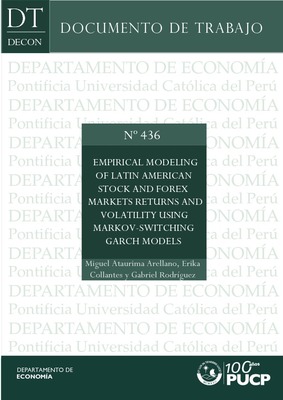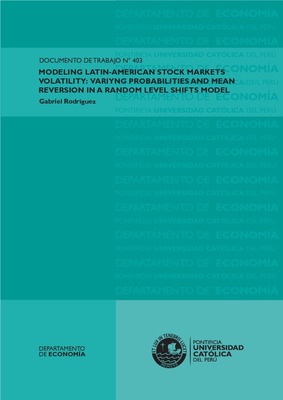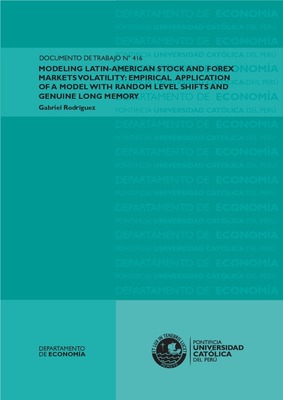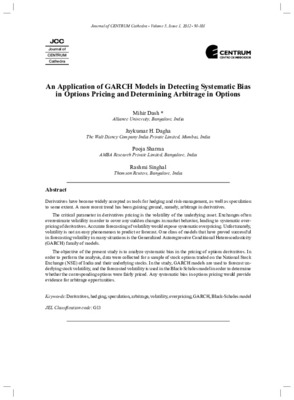| dc.contributor.author | Ataurima Arellano, Miguel | |
| dc.contributor.author | Collantes, Erika | |
| dc.contributor.author | Rodriguez , Gabriel | |
| dc.date.accessioned | 2018-06-28T15:21:45Z | |
| dc.date.available | 2018-06-28T15:21:45Z | |
| dc.date.issued | 2017-03 | |
| dc.identifier.uri | http://repositorio.pucp.edu.pe/index/handle/123456789/126767 | |
| dc.description.abstract | Using a sample of weekly frequency of the stock and Forex markets returns series, we estimate a set of Markov-Switching-Generalized Autoregressive Conditional Heterocedasticity (MS-GARCH) models to a set of Latin American countries (Brazil, Chile, Colombia, Mexico and Peru) with an approach based on both the Monte Carlo Expectation-Maximization (MCEM) and Monte Carlo Maximum Likelihood (MCML) algorithms. The estimates are compared with a standard GARCH, MS and other models. The results show that the volatility persistence is captured differently in the MS and MS-GARCH models. The estimated parameters with a standard GARCH model exacerbates the volatility in almost double compared to MS-GARCH model and a lower likelihood with the other model than MS-GARCH model. There is different behavior of the coefficients and the variance according the two regimes (high and low volatility) by each model in the Latin American stock and Forex markets. There are common episodes related to global international crises and also domestic events producing the different behavior in the volatility of each time series.
Usando una muestra de frecuencia semanal de las series de retornos de los mercados bursátiles y cambiarios, estimamos un conjunto de modelos de heterocedasticidad condicional autorregresiva generalizada Markov-Switching (MS-GARCH) para un conjunto de países Latinoamericanos (Brasil, Chile, Colombia, México y Perú) con un enfoque basado tanto en los algoritmos de maximización de expectativas de Monte Carlo (MCEM) como en los de máxima verosimilitud de Monte Carlo (MCML). Las estimaciones se comparan con un modelos estándares de tipo GARCH, MS y otros. Los resultados muestran que la persistencia de la volatilidad se captura de forma diferente en los modelos MS y MS-GARCH. Los parámetros estimados con un modelo GARCH estándar exacerban la volatilidad en casi el doble en comparación con el modelo MS-GARCH y una menor verosimilitud con el otro modelo comparado con el modelo MS-GARCH. Hay un comportamiento diferente de los coeficientes y la varianza según los dos regímenes (alta y baja volatilidad) por cada modelo en los mercados bursátiles y cambiarios de América Latina. Hay episodios comunes relacionados con las crisis internacionales globales y también con los acontecimientos internos que producen los diferentes comportamientos en la volatilidad de cada serie temporal. | en_US |
| dc.language.iso | spa | es_ES |
| dc.publisher | Pontificia Universidad Católica del Perú. Departamento de Economía | es_ES |
| dc.relation.ispartof | urn:issn:2079-8466 | |
| dc.relation.ispartof | urn:issn:2079-8474 | |
| dc.rights | info:eu-repo/semantics/openAccess | es_ES |
| dc.rights.uri | http://creativecommons.org/licenses/by-nc-nd/2.5/pe/ | * |
| dc.subject | Mercado Bursátil Peruano | es_ES |
| dc.subject | Latin-American Forex market | es_ES |
| dc.subject | GARCH Models | es_ES |
| dc.subject | MS-GARCH Models | es_ES |
| dc.subject | Returns | es_ES |
| dc.subject | Volatilit | es_ES |
| dc.subject | Mercado cambiario de América Latina | es_ES |
| dc.subject | Modelos GARCH | es_ES |
| dc.subject | Modelos MS-GARCH | es_ES |
| dc.subject | Retornos | es_ES |
| dc.subject | Volatilidad | es_ES |
| dc.title | Empirical Modeling of Latin American Stock and Forex Markets Returns and Volatility using Markov-Switching GARCH Models | es_ES |
| dc.type | info:eu-repo/semantics/workingPaper | |
| dc.type.other | Documento de trabajo | |
| dc.subject.ocde | http://purl.org/pe-repo/ocde/ford#5.02.00 | |
| dc.publisher.country | PE | |
| renati.advisor.orcid | https://orcid.org/0000-0003-1174-9642 | |
| renati.advisor.orcid | https://orcid.org/0000-0001-8599-403X | |





